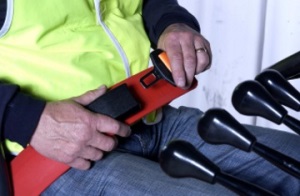Forklift legislation
The largest forklift operator training website in the world
![]()
![]()
Seatbelts On Forklift Trucks

Click here for forklift seatbelt risk assessments
Since December 5th 2002 the majority of fork lift trucks must be fitted with seat belts. This legislation forms part of the Provision and Use of Work Equipment Regulations 1998 (PUWER). Regulation 27 of PUWER refers.
I ran a poll on the subject of forklift seatbelts for the whole of 2009/10 and the results indicate that over 70% of people think that seatbelts should be worn all the time. This leaves me wondering as throughout extensive travels throughout the UK and many other places, I have rarely seen anyone operating a lift truck and wearing a seatbelt except whilst on a training course! In general terms, forklift seatbelts will not be required where:
-
The truck has a high degree of stability making it unlikely that it could overturn when used in its normal operating environment for which it was designed. This would normally apply to all trucks with a capacity greater than 10 tons
-
The truck is a masted truck that can only roll through 90 degrees and features on the truck prevent the operator being trapped between the truck and the ground. This would normally infer an enclosed cab with doors that cannot be held open or removed during routine operations
-
The operator sits sideways and gains access from the rear only. This applies to the majority of reach trucks
-
The truck has a stand - on operator
Trucks of greatest concern are those which may overturn and trap the operator between the truck and the ground or allow him/her to be thrown around in the cab as the truck overturns beyond 90 degrees. Most counterbalanced trucks fall into this category. In order to comply with the regulations users should comply with the forklift seatbelt requirements and should seek advice from the local Factory Inspectorate if they are not sure of the requirements.
It is acknowledged that some older trucks cannot have restraints fitted and some, such as those with unsecured batteries, would become more dangerous if they were. This problem has been overcome by making the actual use of the equipment the determining factor. This means that a risk assessment is required for each task that the truck is likely to perform. In each case an assessment must be made about the potential for overturn and if there is a chance of it then a truck fitted with restraints must be used. If there is a negligible chance that the truck could overturn then a truck without restraints may be used.
Since the safety of lift truck operators is the responsibility of the employer it follows that the employer must be responsible for the risk assessment and must be capable of identifying a low risk of truck overturn.
The regulations also have the effect that newly hired trucks be treated as new. This means that trucks coming under a new hire arrangement should be fitted with restraints. Where this is impracticable then again a risk assessment is required by the employer to justify a low risk of overturn when the truck is in use. It would be a good idea in these circumstances if the risk assessment were to be conducted jointly by the supplier and the employer and in reality many companies will do this. It should remain clear however that the final responsibility for the risk assessment rests solely with the employer.